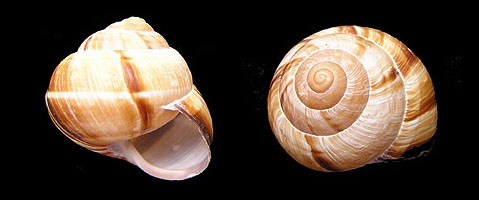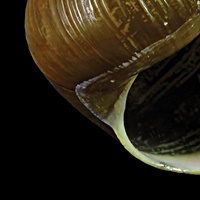![]() Shell characters that can be used for
identification purposes.
Shell characters that can be used for
identification purposes.
|
|
|
Place of Origin: Switzerland, Les Diablerets, in grass after rain.
Summer 2001.
Source of Shell: conchology.be.
Dimensions:
Height: 30 – 50 mm.
Description:
Spherical bulbous shell with 5 - 6 rounded whorls. Aperture rim rounded and
curved back to form an apertural lip. Umbilicus tiny, covered by columellar
apertural lip. Shell creamy white in colour, dark longitudinal band sometimes
hardly visible. Shell surface with distinct lateral growth stripes.
Habitat:
An inhabitant of open hedges, bushes and forest rims on ground rich in
lime. Avoids exposed areas strongly shone by the sun and dark forest areas.
Sometimes synanthropic in gardens and farms, also rarely in vineyards. In the
Alps as occurring as high as 2000 m above sea level.
Distribution:
Central and Southeast Europe: From Central France and Southern England
in the West as far as Belarus and Western Ukraine in the East, Northern Italy in
the South, Macedonia in the Southeast.
|
|
|
Place of Origin: Turkey, Trabzon Vilayet, Sumelas Manastyr (Macka),
May 1992.
Source of shell: conchology.be
 Helix lucorum, pale variety. |
|
Source of shell: German Institute for Heliciculture.
Dimensions:
Width: 45 – 55 mm.
Height: 30 – 60 mm.
Description:
Shell depressedly spherical in shape with blunt apex. Aperture slightly
flattened and laterally oblique, no clear apertural lip, aperture rim folded
back over the small umbilicus in the columellar area. Shell surface granular and
finely striped. Base colour whitish yellow with broad dark bands on almost all
the whorl's width.
Habitat:
Bushes, open forests and agricultural areas. Active usually only in the
night and after rain, dug into the ground during dry periods.
Distribution:
Eastern Mediterranean: From Italy (Western Apennine) over the Central
Balkan including Southern Romania and Bulgaria, Albania and Thrace as far as
Asia Minor and the Eastern Black Sea region.
Remark:
Sold as "Escargot Turc" (Turkish Snail). Giant varieties from
Turkey (H. lucorum taurica) are used for cultivation.
|
|
|
Place of Origin: Rhodes, Rhodes City, near the Acropolis, under stones
and on plants.
May 1998
Source of shell: conchology.be.
|
|
|
Source of shell: German Institute for Heliciculture.
Dimensions:
Width: 25 – 40 mm.
Height: 25 – 30 mm.
Description:
Shell wall comparatively thin, spherical in form with strongly extended
last whorl. Shell surface wrinkled network-like. Base colour yellowish brown
with yellow zic-zac pattern. Apertural rim strongly extended and folded back to
form a lip. Apertural lip distinctly white. Umbilicus usually covered by the
columellar part of the apertural lip. Very variable in appearance.
Habitat:
Bushes, open forest, rocky steppes and sand hills. Often also in
cultivated biotopes of all sorts (English: "garden snail").
Distribution:
All of the Mediterranean and the Atlantic coastal area as far as the
Netherlands and the British Isles. On the British Isles much more common than H.
pomatia. In Germany introduced into the Upper Rhine Valley and in the Lower
Rhine area. In Austria also introduced on cars (!). By food transports from the
Mediterranean distributed almost world-wide, also in the United States and Australia, there
sometimes regarded as a garden or agricultural pest.
Remark:
Other known systematic names are Helix aspersa und Cryptomphalus
aspersus. According to CLECOM,
though, Cornu aspersum
(O.F. Müller 1774) is the valid
and systematically correct name. Other opinions, for example, are published by Turner et al. (1998)
and Giusti et al.
(1996) (also see: "The
Cornu Problem").
Literature:
|
|
|
Source of shell: German Institute for Heliciculture.
Dimensions:
Width: 35 – 60 mm.
Height: 30 – 55 mm.
Description:
Shell with widely conical spire and blunt apex. Last whorl very wide and
extended. Base colour yellowish brown or whitish with narrow bands. Third and
fourth band separated distinctly far. Apertural rim little extended and blunt,
in the columellar area often covering the closed umbilicus.
Habitat:
Usually in rocky biotopes, as high as 1600 m above sea level.
Distribution:
From the coastal area of Croatia over Dalmatia, the Dalmatian islands
and Western Montenegro, as far as North-Western Albania. Exclusively in karst
areas. More strongly ribbed race in a separated distribution area in Southern
Albania, Northern Greece and on Corfu.
|
|
|
Cantareus apertus. Picture: Fabio Liberto (Source).
Dimensions:
Width: 20 – 25 mm.
Height: 20 – 25 mm.
Description:
Shell walls thin, shell spherical in form. Widely extended last whorl, larger
than the remaining spire. Rather glossy shell, surface irregularly ribbed. Base
colour olive green without recognisable bands. Umbilicus missing.
 Cantareus apertus. Picture: F. Liberto. |
![]() Right: Close
up view of Cantareus
apertus. Well visible: The characteristic enamel layer in front of the
aperture, as well as the missing umbilicus.
Right: Close
up view of Cantareus
apertus. Well visible: The characteristic enamel layer in front of the
aperture, as well as the missing umbilicus.
Habitat:
Macchia shrubs, field groves and vineyards.
Distribution:
France west of the Rhône mouth, Liguria, Tuscany and Southern Italy.
Islands of the Tyrrhenian Sea, Ionic islands, Central Greece, Aegean islands,
Cyprus, Mediterranean North Africa.
Remark:
Foot of the living snail very large compared to the shell, with two
distinct dark longitudinal bands, bluish back stripe and flanks. During periods
of dryness the animal aestivates dug into the ground. The snail's systematic
name is because of the grunting sound it makes, when it is disturbed. In France
this snail may only be picked for personal consumption.